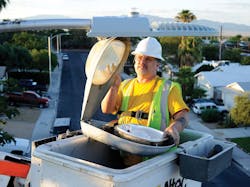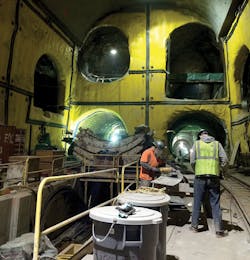Contractors Unite to Improve America’s Infrastructure
As the nation’s infrastructure has aged and deteriorated, the estimated cost to make improvements has more than tripled, according to the American Society of Civil Engineers (ASCE). The United States has consistently maintained a “D” average on ASCE’s Infrastructure Report Card since 2001, and 2017 was no exception. Once again, America’s infrastructure fell in the “poor, at risk” category with a D+ grade (see Grading America’s Infrastructure). By looking at 16 different infrastructure categories for the report, civil engineers concluded America’s infrastructure is “mostly below standard, with many elements approaching the end of their service life.” In addition, “a large portion of the system exhibits significant deterioration, and condition and capacity are of serious concern with strong risk of failure.” The ASCE states the nation is currently at a crossroads, and deteriorating infrastructure is impeding the ability to compete in the thriving global economy.
“While we have made some progress, reversing the trajectory after decades of underinvestment in our infrastructure requires transformative action from Congress, states, infrastructure owners, and the American people,” ASCE states in its report.
In its “Failure to Act” report, the ASCE estimated that if America doesn’t address the investment gap in infrastructure by 2025, the economy could stand to lose nearly $4 billion in GDP along with 2.5 million jobs. In addition, each household could lose $3,400 in disposable income due to infrastructure deficiencies, such as congested roadways.
To elevate America’s grade to an “A” (exceptional and fit for the future) — before it slides to an “F” (failing, critical, and unfit for purpose) — investment is needed today, not tomorrow, says Marco Giamberardino, executive director of government affairs for the National Electrical Contractors Association (NECA). In fact, the ASCE estimates that $4.59 trillion in investments is needed by 2025.
“We, as a country, simply have not been making the needed investments necessary to maintain, much less upgrade and modernize, our infrastructure,” Giamberardino says. “We believe this is something that needs to begin as soon as possible and be continually developed. The time for inaction must end. The cost of rebuilding our nation has doubled in the last several years. It will only cost more if we delay.”
Improving infrastructure
To “Make America Great Again,” President Donald Trump said the time has come to rebuild the nation’s infrastructure. As such, he recently met with infrastructure business leaders and announced his plan to Congress.
“To launch our national rebuilding, I will be asking Congress to approve legislation that produces a $1 trillion investment in infrastructure through the United States — financed through both public and private capital — creating millions of new jobs,” Trump stated on his campaign website.
After discussing his plans for infrastructure in his victory speech and pledging to address this issue in his first 100 days in office, however, the Trump administration may put the infrastructure plan on the back burner until 2018. Currently, the team is focused on other issues, including tax reform, immigration, and the repeal of Obamacare. In turn, Trump’s trillion-dollar infrastructure plan has seemingly disappeared from the White House radar, according to the New York Times.
While construction-related stocks experienced a “post-election boost” due to Trump’s infrastructure plan, some of these stocks dropped after news of a possible delay hit Wall Street, according to Investor’s Business Daily.
The precise time line for the infrastructure plan may yet be unknown, but the construction industry is still preparing for possible opportunities down the road. For example, when the Trump administration issued an executive order on infrastructure on
January 25, it sparked the interest of electrical contracting firms nationwide.
For example, 60% of E-J Electric Installation Co.’s workload stems from the infrastructure market, and its electricians are heavily involved with improving infrastructure throughout the New York metro region. Case in point: the Long Island City, N.Y.-based, family-owned electrical contracting firm is working on East Side Access and Atlantic Yards; roadway improvements like LED street lighting and cashless tolls; power work for CPV Valley Energy; and water treatment work at a dam and plant.
“New York City overall is investing billions in infrastructure from monumental projects like the Second Avenue Subway to the redevelopment of the LaGuardia Airport (LGA) to the long overdue Kosciuszko Bridge,” says Tony Mann, president and CEO of
E-J Electric, which ranked 26th on EC&M’s 2016 Top 50 electrical contractors listing. “These important investments help the millions of commuters travel safely daily and provide stable infrastructure for years to come.”
Within New York, Mann says he’s seeing a major transformation take place. For example, the LGA redevelopment is currently underway with the JFK and Newark airports shortly behind. In addition, the Port Authority Bus Terminal is considering a redevelopment, the Moynihan Station/Penn Station is currently being overhauled, and New York City is continuing to focus on all types of transit work.
“Each year, there has been a steady increase in growth of passengers, and infrastructure needs to keep up,” Mann says. “There are plans for development of much-needed improvements to major infrastructure. Also, updating the electric grid and telecom systems would address the high cybersecurity risks that we face.”
Realistically, however, Mann says this new construction only covers a fraction of the construction costs for the major upgrades needed long-term. The new executive order, however, provides opportunities for electrical contracting firms nationwide.
“The federal funding will help local authorities and agencies to plan for the infrastructure improvements that they want and desperately need,” Mann says.
Another EC&M Top 50 contractor — Five Star Electric, which ranked No. 10 on EC&M’s 2016 listing — is also working on many infrastructure projects in New York City, including the George Washington Bridge Bus Terminal Upgrade, 86th Street Station on the Second Avenue Subway Line, the Hudson Yards Eastern Rail Yard, and the East Side Access project. When completed, the East Side Access will serve about 162,000 customers a day, providing a faster and easier train commute from Long Island and Queens to the east side of Manhattan in a new terminal and concourse below Grand Central Terminal.
“We have been working on several contracts for the Metropolitan Transit Authority at East Side Access and plan to be out there for many more years,” says Russ Lancey, vice president and chief estimator for Five Star Electric. “It is one of the largest, high-profile transportation projects currently underway in the United States, and we are fortunate to be involved.”
Within New York City, infrastructure bidding is at unprecedented levels, Lancey reports.
“There’s no shortage of opportunity in public sectors, and there is a bidding boom in the infrastructure sector,” he says.
Lancey forecasts future growth for the infrastructure market due to President Trump’s support of infrastructure spending and job creation.
“It will have a positive impact on the electrical contracting industry because it will increase public spending and create jobs,” Lancey says. “I don’t see it turning negatively anytime soon. Instead, I see it ramping up and being positive for anyone in the infrastructure space for the next few years.”
Giamberardino also says rebuilding the nation’s infrastructure will translate into job opportunities for contractors to bid and real work for their employees.
“The needs are out there, and our contractors are ready, willing, and have the knowledge and capacity to carry out this mission,” Giamberardino says. “NECA supports the President’s call for a $1 trillion investment in our infrastructure, and we stand ready willing and able to help make it happen.”
For example, he says NECA contractors play a crucial role in the building and maintaining of the nation’s infrastructure.
“Our members light our nation’s highways and streets; connect rail switches; install complex electrical systems at airports; erect the towers and build the substations that bring power and light to our schools and hospitals, and so much more,” Giamberardino says. “We believe that if the new administration delivers on its promise to invest in our infrastructure, it will be a huge boost for the electrical construction industry across all sectors.”
Expediting reviews
According to the executive order, the administration strives to “streamline and expedite, consistent with law” environmental reviews for infrastructure projects. In particular, projects to improve the electric grid and telecom systems or repair and upgrade port facilities, airports, pipelines, bridges, and highways will be considered “high priority.”
To determine which projects earn this status, the state governor or the head of any executive department or agency must first issue a request. Within 30 days of this request, the Chairman of the White House Council on Environmental Quality will determine if the infrastructure project qualifies, Mann says.
For example, the chairman will select high-priority projects based on their impact on the general welfare, value to the United States, environmental benefits, and other relevant factors, according to Baker Botts, a Washington D.C.-based law firm. Once the project is considered a “high priority,” the chairman will then work with agency heads to establish expedited procedures and deadlines to wrap up environmental reviews and approvals. In turn, the agencies must meet the deadlines or provide a written explanation to the chairman.
Jay Ryan, a partner in the Baker Botts firm, says the executive order demonstrates the Trump Administration’s intent to create conditions that provide incentives for capital deployment in major infrastructure projects across many industry sectors.
“The Trump Administration is carrying through on a campaign promise to reduce the regulatory burdens associated with developing and commercializing infrastructure so that investment capital can be deployed efficiently,” Ryan says.
NECA has been a strong advocate for streamlining the permitting process across the board, Giamberardino says.
“Layers of regulation between federal, state, and local authorities can delay projects for years on end,” Giamberardino says. “While we recognize the need to protect the environment, our contractors need greater clarity and certainty during the regulatory process. The permitting process can sometimes be an endless regulatory morass.”
Instead, Giamberardino says, there should be a set time to begin and end the review of the project in a timely manner.
“We have lost that, and it is costing this nation dearly,” Giamberardino says. “Streamlining the process also will deliver needed projects faster and at a greater value to the American taxpayer.”
The administration must work with state and local leaders to determine which investments are sorely needed, Giamberardino says. Because the investment will require taxpayer dollars, it is necessary to ensure the funding is spent wisely, he says.
“We must ensure project prioritization closely examines what projects will bring the best results for the local economy, ensure safety, reduce traffic, and provide additional efficiencies,” Giamberardino continues. “We will also need to examine what the over costs to operate and maintain these priority projects.”
In his view, Lancey says the increased investment in infrastructure will generate more bidding opportunities.
“The bottom line is that an increase in spending will produce more projects, more construction revenue, and more jobs,” Lancey says. “The construction market will continue to grow, especially with a presidential administration that supports it.”
Currently, Mann says many government agencies lack the urgency to complete projects, yet the new presidential administration’s approach to infrastructure projects could not only increase spending, but also decrease project time lines due to lean construction practices.
“With the possible expediting of environmental reviews on infrastructure projects, I am confident that New York will be seeing an increase in construction,” says Mann.
Funding the investment
According to Giamberardino, one of the most daunting challenges revolving around the executive order is how to finance the infrastructure investment. He says America must think differently about how to approach this issue.
“It costs money to build, but to defer critical repairs and new projects only costs more in the long run,” Giamberardino says. “NECA has long advocated that we focus on doing the things that have worked such as shoring up dedicated infrastructure trust funds, and the need to address the user fee system.”
For example, the surface transportation program user fee has not increased in nearly 25 years, and he says the nation needs to restore its purchasing power and ensure it is never depleted. In addition, the United States must reexamine the role private investors have in this arena and discover how the public can help to pay to ensure the infrastructure works for all Americans.
“The biggest challenge in the end is finding a way to pay for these needed investments,” Giamberardino says. “Congress and the administration are going to have to find a way to work together and be open to new ideas and understand that what we spend today will bring our nation greater dividends.”
Alex Carrick, chief economist for ConstructConnect, agreed that the primary challenge right now is finding the money — public or private — to actually do the work.
“Governments all around the world know this has to happen,” Carrick says. “Every single government has some type of infrastructure initiative. Some are trying to do it with public funds, others are doing it through public-private partnerships, and others are trying infrastructure banks. There are so many different options, and it still has to be worked out.”
The United States may not only be challenged by the question of financing, but also by future interest rates.
“They’re likely to be more up than down in the future,” Carrick says.
Beyond financing the investment, another major obstacle, from an electrical contractor point of view, centers around capacity, Lancey says.
“The jobs are large in size, and there are only so many people that can handle and have the resources to complete work of that magnitude,” Lancey says. “The only negative challenge I see coming down the pike is hitting a capacity restriction in the industry. We’re not there yet, however, and it’s very positive now. There’s a lot of high-profile, important work coming out right now, and we are looking forward to what the future holds.”
Economic impact
While there are still many unknowns with regard to the administration’s plan for infrastructure spending, Carrick considers the new executive order good news for the electrical contracting industry.
“How can they turn away from this? It’s all positive,” Carrick says.
At this point, however, not everyone agrees with the effect of infrastructure investment on the economy. While supporters think it’s worthwhile to invest money in infrastructure, the naysayers claim the effect on the economy will only be temporary.
“They say it will increase so many construction jobs, but once the work is finished, the work goes away and it doesn’t have a lasting impact on the economy,” Carrick says. “I find it challenging to overcome that perception.”
In his view, Carrick believes the entire world economy revolves around one simple word — logistics.
“It’s all about moving goods, services, and people faster, cheaper, safer, and greener,” Carrick says. “All of our jobs essentially focus on moving something, whether it’s data over the Internet, electricity over power lines, or goods over highways. Everything is in flux.”
While the United States is trying to get its technology out before other nations, it may already be behind, Carrick says.
“Other nations aren’t standing still on technology and infrastructure, and everyone is competing,” Carrick says. “In America, we tend to think we are as leading-edge as can be, but if you go to China, you will be knocked over by their airports, transit systems, and even bridge building machines.”
If logistics govern the world, then the need for infrastructure becomes paramount, Carrick says. Lately, he says logistics and productivity enhancements have become virtually synonymous, particularly with “hard” infrastructure like sewers and roadways.
“The push for hard infrastructure is not just about temporarily increasing the number of construction jobs, but it’s also about bringing down costs and moving goods,” Carrick says. “To me, the logic for infrastructure is very apparent. It’s very short-sighted to just focus on the construction jobs.”
Overall, Carrick believes the investment in infrastructure means everything to the economy.
“I’m all in favor of infrastructure,” Carrick says. “This is where it’s got to happen. It’s where the growth is coming from.”
Fischbach is a freelance writer based in Overland Park, Kansas. She can be reached at [email protected].
SIDEBAR: Grading America’s Infrastructure
Every four years, the American Society of Civil Engineers (ASCE) releases the Report Card for America’s Infrastructure. This report researches the current infrastructure’s conditions and needs and makes recommendations to elevate the marks. Here’s how the 16 infrastructure categories stacked up for 2017 based upon capacity, condition, funding, future need, operations and maintenance, public safety, resilience, and innovation.
Bridges (C+) — 9.1% are considered structurally deficient.
Aviation (D) — Serve 2 million passengers daily in U.S. airports.
Dams (D) — 17% are identified as high-hazard potential.
Schools (D+) — 53% need improvements to reach a good condition.
Drinking Water (D) — 6 billion gallons of treated water are lost every day.
Solid Waste (C+) — 258 million tons of municipal solid waste is generated in one year.
Parks (D+) — $11.9 billion in National Park Service deferred maintenance.
Roads (D) — 6.9 billion hours in delayed traffic or 42 hours per driver.
Levees (D) — More than $1.3 trillion in property value behind levees.
Ports (C+) — 99% of America’s overseas trade passes through ports.
Transit (D-) — Backlog of $90 billion in transit maintenance.
Rail (B) — $27 billion in improvements in one year by the freight railroads.
Hazardous Waste (D+) — 53% of Americans live within three miles of a hazardous waste site.
Inland Waterways (D) — 49% of vessels experience delays across the inland waterways system.
Energy (D+) — 3,571 total power outages reported in one year.
Wastewater (D+) — Demand on treatment plants will grow by more than 23% by 2032.
Source: American Society of Civil Engineers 2017 Report Card for America’s Infrastructure



